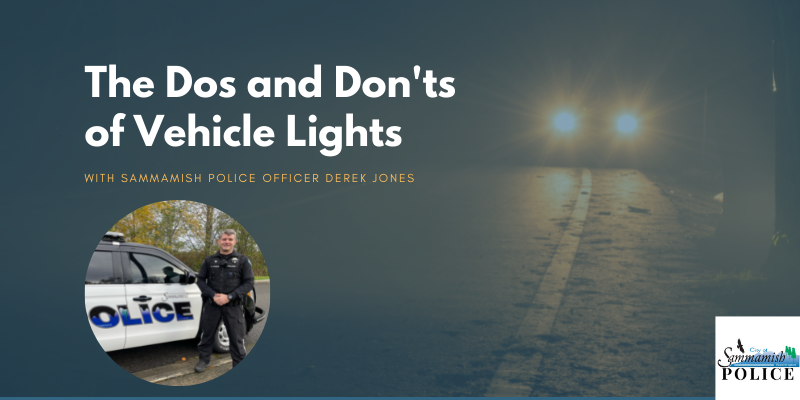
The Dos and Don'ts of Vehicle Lights with Sammamish Police
Proper use of vehicle lights makes our roads safer for drivers, bicyclists, and pedestrians. Here's everything you need to know about how to use the lights on your vehicle.
When are lights required? (RCW 46.37.020)
- 30 minutes after sunset to 30 minutes before sunrise
- Any time when people and vehicles on the highway aren’t clearly discernible at 1000 feet (insufficient light, inclement weather)
- Two headlights, two red tail lamps, and three brake lamps are required
Headlights vs. Daytime Running Lights (DRLs)
- DRLs are designed to be dimmer than headlights and are generally not sufficient to light the road ahead or meet headlight requirements
- Generally don’t illuminate tail lights
High Beams vs. Low Beams (RCW 46.37.230)
- High beam indicators have been required in WA since 1948
- Lights must be dimmed when a vehicle approaches w/in 500 feet to the front or 300 feet to the rear
Auxiliary Lighting (off-road light bars, colored lights)
- Spot lamps, fog lamps (amber or white), passing lamps (white or amber), and driving lamps (white) are all permitted, provided you don’t have more than two of one type and they’re mounted at the proper height and don’t hit the eyes of approaching drivers
- Can’t be used in lieu of headlamps when lights are required
- The only colors of light that can be visible from the front of vehicles are amber and white. Only red and amber lights can be visible from the rear
- No “aftermarket neon lighting devices” can be displayed while a vehicle is in motion on a public roadway
Covers on Headlights and Taillights
- Nothing that impairs the effectiveness of required lighting equipment can be placed on a vehicle on the road (WAC 204-21-230)
That's vehicle lighting in a nutshell! Thanks for watching. If you have a topic you’d like to see covered in a future video, email communications@sammamish.us.
